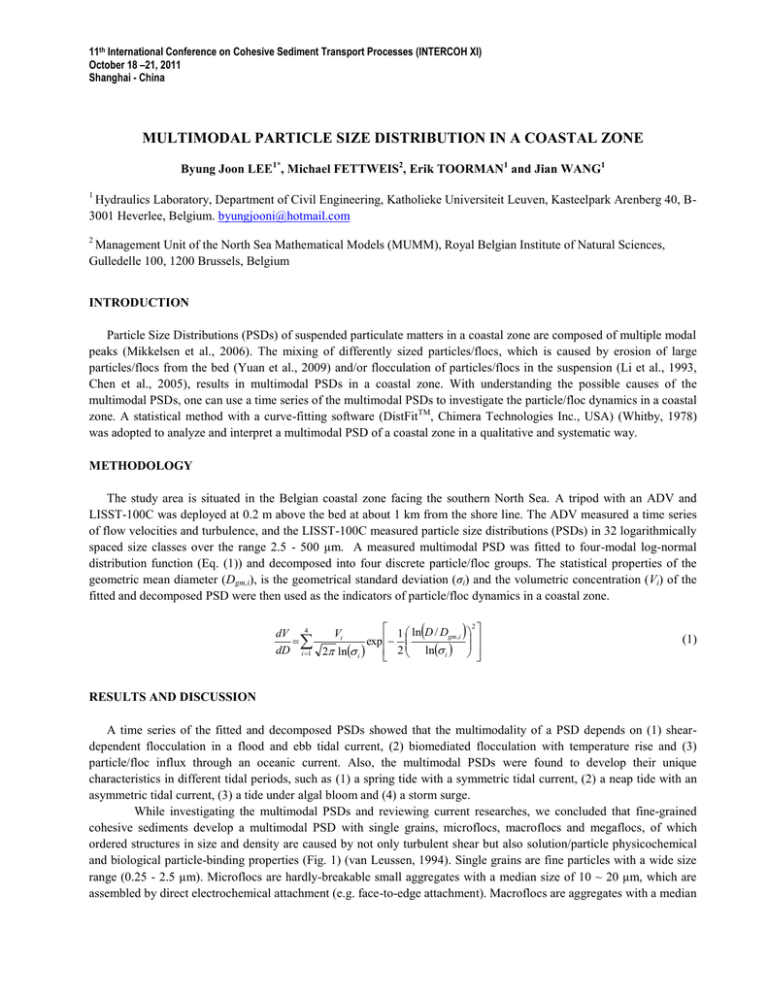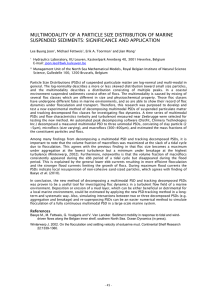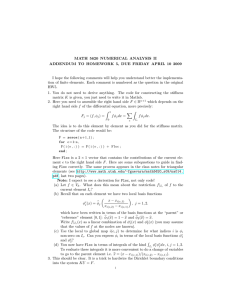Document 11675211
advertisement

11th International Conference on Cohesive Sediment Transport Processes (INTERCOH XI) October 18 –21, 2011 Shanghai - China MULTIMODAL PARTICLE SIZE DISTRIBUTION IN A COASTAL ZONE Byung Joon LEE1*, Michael FETTWEIS2, Erik TOORMAN1 and Jian WANG1 1 Hydraulics Laboratory, Department of Civil Engineering, Katholieke Universiteit Leuven, Kasteelpark Arenberg 40, B3001 Heverlee, Belgium. byungjooni@hotmail.com 2 Management Unit of the North Sea Mathematical Models (MUMM), Royal Belgian Institute of Natural Sciences, Gulledelle 100, 1200 Brussels, Belgium INTRODUCTION Particle Size Distributions (PSDs) of suspended particulate matters in a coastal zone are composed of multiple modal peaks (Mikkelsen et al., 2006). The mixing of differently sized particles/flocs, which is caused by erosion of large particles/flocs from the bed (Yuan et al., 2009) and/or flocculation of particles/flocs in the suspension (Li et al., 1993, Chen et al., 2005), results in multimodal PSDs in a coastal zone. With understanding the possible causes of the multimodal PSDs, one can use a time series of the multimodal PSDs to investigate the particle/floc dynamics in a coastal zone. A statistical method with a curve-fitting software (DistFitTM, Chimera Technologies Inc., USA) (Whitby, 1978) was adopted to analyze and interpret a multimodal PSD of a coastal zone in a qualitative and systematic way. METHODOLOGY The study area is situated in the Belgian coastal zone facing the southern North Sea. A tripod with an ADV and LISST-100C was deployed at 0.2 m above the bed at about 1 km from the shore line. The ADV measured a time series of flow velocities and turbulence, and the LISST-100C measured particle size distributions (PSDs) in 32 logarithmically spaced size classes over the range 2.5 - 500 µm. A measured multimodal PSD was fitted to four-modal log-normal distribution function (Eq. (1)) and decomposed into four discrete particle/floc groups. The statistical properties of the geometric mean diameter (Dgm,i), is the geometrical standard deviation (σi) and the volumetric concentration (Vi) of the fitted and decomposed PSD were then used as the indicators of particle/floc dynamics in a coastal zone. 1 ln D / D dV 4 Vi gm , i exp dD i 1 2 ln i 2 ln i 2 (1) RESULTS AND DISCUSSION A time series of the fitted and decomposed PSDs showed that the multimodality of a PSD depends on (1) sheardependent flocculation in a flood and ebb tidal current, (2) biomediated flocculation with temperature rise and (3) particle/floc influx through an oceanic current. Also, the multimodal PSDs were found to develop their unique characteristics in different tidal periods, such as (1) a spring tide with a symmetric tidal current, (2) a neap tide with an asymmetric tidal current, (3) a tide under algal bloom and (4) a storm surge. While investigating the multimodal PSDs and reviewing current researches, we concluded that fine-grained cohesive sediments develop a multimodal PSD with single grains, microflocs, macroflocs and megaflocs, of which ordered structures in size and density are caused by not only turbulent shear but also solution/particle physicochemical and biological particle-binding properties (Fig. 1) (van Leussen, 1994). Single grains are fine particles with a wide size range (0.25 - 2.5 µm). Microflocs are hardly-breakable small aggregates with a median size of 10 ~ 20 µm, which are assembled by direct electrochemical attachment (e.g. face-to-edge attachment). Macroflocs are aggregates with a median size of 20 ~ 200 µm, which are assembled by reduction of electrostatic repulsion between particles/flocs with particle charge-diluting counter ions (Lee et al., 2011). Megaflocs are aggregates with a median size over 200 µm, which are formed by the gluing capability of microbial exudates (EPS or TEP) (Chen et al., 2005). When fine-grained cohesive sediments are placed in a turbulent shear field of a coastal zone, they will soon develop the ordered structures of single grains, microflocs, macroflocs, and megaflocs, under the cooperative action of shear-dependent and physicochemicallyand biologically-mediated flocculation with abundant salt ions and microbial exudates in the brackish water. dW/dln(D) (L/m) 300 Microfloc 10 ~ 20 µm 250 Macrofloc 20 ~ 200 µm Megafloc > 200 µm 200 150 Single Grain 0.25 ~ 2.5 µm 100 50 0 1 10 100 Floc Diameter (D; m) 1000 Fig. 1 A multimodal PSD and schematic diagrams of the discrete particle/floc groups CONCLUSIONS The dynamic behaviors of the multimodal PSDs in a coastal zone were successfully investigated and analyzed in a quantitative and systematic way with the new curve fitting analysis. This research also proved that a multimodal PSD could be discretized into single grains, microflocs, macroflocs and megaflocs for a practical purpose in modeling and simulation. This could be a theoretical background of the recently-developed flocculation model consisting of microflocs and macroflocs (Lee et al., 2011), for further applications as an easy alternative of elaborate flocculation models (Verney et al., 2009). ACKNOWLEDGEMENT The authors would like to acknowledge the Flemish Science Foundation (FWO Vlaanderen) for funding the FWO project no. G.0263.08. The study was partly funded by the Maritime Access Division of the Ministry of the Flemish Community (MOMO project). REFERENCES Chen, M., S. Wartel, and S. Temmerman. (2005). Seasonal variation of floc characteristics on tidal flats, the Scheldt estuary. Hydrobiologia. 540: 181-195. Lee, B., E. Toorman, F. Molz, and J. Wang. (2011). A two-class population balance equation yielding bimodal flocculation of marine or estuarine sediments. Water Research. 45(5): 2131-2145. Li, Y., Wolanski, E. and Xie, Q. (1993) Coagulation and settling of suspended sediment in the Jiajiang river estuary. China. Journal of Coastal Research. 9(2):390-402. van Leussen, W. (1994). Estuarine Macroflocs: Their role in fine-grained sediment transport. Universiteit van Utrecht, the Netherlands Mikkelsen, O., P. Hill, and T. Milligan. (2006). Single-grain, microfloc and macrofloc volume variations observed with a LISST-100 and a digital floc camera. Journal of Sea Research. 55: 87-102. Verney, R., R. Lafite, and J. Brun-Cottan. (2009). Flocculation potential of estuarine particles: The importance of environmental factors and of the spatial and seasonal variability of suspended particulate matter. Estuarines and Coasts. 32: 678-693. Whitby, K. (1978). The physical characteristics of sulfur aerosols. Atmospheric Environment. 41: S25-S49. Yuan, Y., H. Wei, L. Zhao, and Y. Cao. (2009). Implications of intermittent turbulent bursts for sediment resuspension in a coastal bottom boundary layer: A field study in the western Yellow Sea, China. Marine Geology. 263: 87-96.





